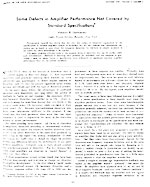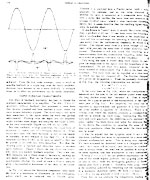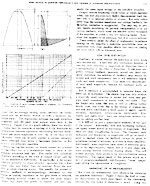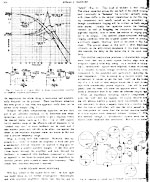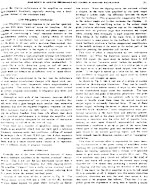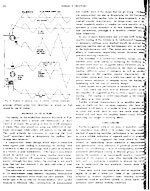"Some Defects in Amplifier Performance Not Covered by Standard Specifications" by Norman Crowhurst
Journal AES, October 1957, V.5, N.4
Some Defects in Amplifier Performance Not Covered by Standard Specifications*
Norman H. Crowhurst
Audio Design Service, Bayside, New York
Journal of the Audio Engineering Society, October 1957
typed version, no graphics, www.milbert.com
Physiological research has shown that the very low orders of distortion represented by the specifications of modern amplifiers should be inaudible, but the fact remains that considerable distortion can be heard in cases where the measured distortion, by methods at present standard, is far below the limits determined to be inaudible.
This paper examines critically some of the possible forms of distortion that can be audible under such circumstances. Methods of detecting their presence are described with the intention of providing a basis for future forms of specification more indicative of significant practical amplifier performance than are the present standards.
Subjective tests on the amount of distortion that is audible appear to show two things: (1) that improved equipment and practiced listening have enabled us both collectively and individually, to detect smaller degrees of distortion: and (2) that the amount registered varies widely between individuals and with the type of distortion present.
In the early days, before the advantages of push-pull operation were discovered, and long before the advent of feedback to "solve all our troubles," the minimum detectable harmonic distortion was settled on as 5%. More recent tests along the same lines showed that two-thirds of the subjects could detect 5% harmonic, while one-third of them could detect 1%. Because intermodulation distortion produces some inharmonic additions to the program, it was found that this kind, produced when more than one input frequency is used, is responsible for more of the distortion noticed in actual performance.
But some puzzling facts remain. All forms of distortion in amplifiers, measured according to conventional methods, are either so far below the minimum audible distortion level, or are so far below distortion of the same kind produced by other links in the chain--the pickup, the loudspeaker, or even the human ear itself--that it should no longer be possible to hear any difference between the performance of any good modern amplifiers. Certainly none of them should produce any audible component of distortion. The fact remains that some good amplifiers are observed to "sound cleaner" in some way than others.
A closer examination reveals certain trends that have been followed long enough, and it is time to change our direction in amplifier development. In the days when a "good" audio amplifier produced around 5% harmonic distortion and a frequency response within 3db from 100 to 5000cps, improvement in these respects was audible. Probably hum level and background noise level of those days showed room for improvement too. But work has gone on until fabulous figures of performance are achieved--distortion in the region of 0.1% (and some even lower) and frequency response from a fraction of a cycle up to the region of a megacycle within 0.1 db or so. By the figures, such amplifiers should rate as audibly perfect.
This trend seems to have been followed because of a belief that a better specification in these regards must mean the amplifier performs better. Even when some knowledgeable people realized this is not true any more, because of the standard generally achieved, the trend has persisted, because promotion has made the market--or at least sections of it--"specification conscious." Some, of course, have discovered for themselves that the audible performance does not appear to be related to the figures on the specification and have concluded that "specifications are valueless--the only reliable test is to listen to it."
As a result, for a few years now, progressive amplifier designers have been faced by an anomaly: the need to design an amplifier that works well and also gives a good specification! One that reads lower-than-necessary figures for the distortion and frequency response deviation, and at the same time will sell to the people who judge by listening to it. While a sudden change in presentation can hardly be expected, it would be good to find a way of getting the information published in specification form that is a little more closely related to what the amplifier sounds like.
About a couple of decades ago, degenerative feedback was hailed as the amplifier maker's "godsend"--the more the better! So amplifiers have appeared with 20, 40, 60, and 80 db of negative feedback--and even with "infinite feedback"! It is largely this feedback that has enabled such low figures in distortion and frequency response deviation to be
* Presented October 12, 1957 at the Ninth Annual Convention of the Audio Engineering Society, New York
p. 195
Fig. 1 Harmonic relationship in clipped wave. (a) Example of clipped output wave form. (b) Distortion component of (a) to 10 times scale with dashed lines first two terms of series analysis.
~~achieved. From the first crude attempts, using as much as possible feedback in a single loop over the whole amplifier, designers have learned to use it more skillfully, in multiple loops so its effect on performance can be better controlled.
SIMPLE OVERLOAD CHARACTERISTIC
One effect of feedback, inevitably, has been to change the overload characteristic of an amplifier. The older "Class A" amplifiers, without feedback, first produced a wave form that became rounded and later reached a point where the wave became definitely clipped. The rated output may have been somewhere in the region where the wave was getting well-rounded. Pushing twice the input into the amplifier might overbias some stages and compress the signal a little, so the wave eventually clipped but still not too badly.
But with feedback, in large quantities, the ***main*** form of distortion is "taken care of"--virtually eliminated. What would have been 10% third harmonic (a very serious degree of rounding) is now reduced to less than 1% (or in some instances less than 0.1%), so we have an amplifier that can be pushed so far with very little distortion. But then the clipping point is reached, and distortion starts to increase quite suddenly. Figure 1 shows the way distortion invariably starts in a modern feedback amplifier. This is not just third harmonic but a whole range of harmonics reaching up into higher orders. This can be Fourier analyzed, but it is questionable whether the result of such a Fourier analysis gives a representative impression of the effect of the distortion.
As Fig.1(b) shows, the distortion component really takes the form of a succession of alternately up- and down-going pulses which can be analyzed into a Fourier series. Whether it is analyzed into a Fourier series (with a wave analyzer, for example) and an RMS value obtained, or whether its value is measured as a composite wave form with a meter that rectifies the wave and measures its average rectified value (which is what harmonic distortion meters do), it seems doubtful that the resulting figure represents its audible effect.
If one listens to "static" hum, it sounds like a buzz, rather than a product of 60 cps. If one feeds more low frequencies into a loudspeaker than it can handle so the diaphragm voice coil hits its end-stops, the knocking is heard as a separate entity from the fundamental frequency at which it is driven. The clipped wave form is a drive voltage (or current) with precisely the same kind of added distortion component. Therefore, it will also sound like knocking, as a separate entity from the fundamental frequency, rather than as a series of spurious overtones for this frequency.
This being the case, it would seem more logical to compare the magnitude of the pulses with the magnitude of the fundamental. To see what this means, compared to the usual method of measurement, Fig.2 shows the basic relationships. The wave form can be regarded as a sine wave in which the tips are chopped off. The fraction chopped off is given in designation a. From the geometry developed in Fig.2(a), the followed relationships are derived:
b = cos ^(-1) * (1+a)
c = sin ^(-1) * 1 / (1+a)
In the wave form of Fig.1(b), where the fundamental is balanced out, the area of the tall narrow pulses must equal the long shallow areas that "balance" it. This is represented, for a quarter period of the fundamental, in the right-hand part of Fig.2(a). For simplicity, two areas can be regarded as approximately one quadrant of a since wave--the areas shaded in opposite 45-deg directions. There is an overlap area where the shading produces a crosshatching, and this is outside the wave form. Subtracting this from both sine wave quadrants, the remaining parts represent the areas "under" the wave above and below the reference line. So we derive this condition by equating the areas of the sine-wave quadrants, when the areas under the wave must also be equal.
It may be argued that the up-going pulse is not a true sine-wave quadrant but must be represented by a more complicated mathematical series. This is being very rigorous. We have assumed the distorted wave is a chopped-off sine wave. As it never will be exactly this (because the feedback used is always finite), we shall not be justified in trying to be more rigorous, and this assumption is very convenient.
Writing b + c = pi / 2, we can produce expressions for the area of the whole shaded portions: the up-going pulse has an area of 2*ab/pi while the down-going quadrant of fundamental sine wave is simply f. Equating these areas, which is the condition achieved by balancing out the fundamental in a harmonic distortion meter, we have f = 2ab/pi. As e+f = a, we can evaluate from e=a*(1-2b/pi).
From this we can evaluate the comparative reading obtained with an average reading meter, between the fundamental and the harmonic residue, as with a harmonic distortion meter. The relationship between the peak distortion component and the peak total output wave form is the fraction a. Figure 2(b) is a graph relating these two results.
Notice that, for example, a reading of 0.1% distortion by conventional methods represents relationship between fundamental and pulse magnitude of over 1%, or less than 40-db differential, which can be quite audible in certain frequency ranges, although most forms of harmonic distortion as low as 0.1% are definitely inaudible.
Before leaving this section, we should answer the question of what effect use of a loudspeaker load, in place of the academic resistance load, has. This varies with individual amplifiers according to the kind of output circuit and the way the feedback is distributed. In particular, if the output tubes are pentodes (or beam tetrodes) operation into a load whose value runs higher than the nominal, limits the grid drive at which clipping occurs. But usually the amount of negative feedback is correspondingly increased by this change in loading impedance so the grid drive is reduced, and clipping actually occurs at about the same output wattage (but much less power, of course) and also very nearly the same input voltage to the complete amplifier.
Output circuits employing triode tubes, or triode-operated tubes, can also accommodate higher-than-nominal load values--this is an inherent ability of triodes. But with values lower than the nominal impedance and voltage feedback, the distortion limitation is exaggerated. The only way to produce results paralleling the pentode compensation is to use current feedback, which raises the effective source resistance of the amplifier, or yields a very low damping factor. Sometimes this happens to be necessary, but it is unconventional.
These remarks about the effect of loudspeaker impedance loading on the amplifier's distortion possibilities have no connection with other possible effects that reactive loading can have which will be discussed later.
LOW LEVEL DISTORTION
Feedback, of course, reduces the distortion at lower levels very successfully. A fact that gets overlooked, however, is that for each reduction in magnitude of distortion there is a multiplication of the order of distortion. If the basic amplifier, without feedback, generates second and third harmonic distortion, the addition of feedback may reduce the second and third components, but it will introduce fourth, sixth, and ninth components. True these are, theoretically, of very small magnitude, because the feedback works on them too.
But if feedback is accomplished in separate loops, the effect can be multiplied. The shorter loop may only produce a relatively small reduction in second and third, and generate small components of fourth, sixth, and ninth. Then the longer loop takes this and, as well as adding further fourth, sixth, and ninth, due to the reside of original second and third, contributes a small quota of eighth, twelfth, sixteenth, eighteenth, twenty-fourth, thirty-sixth, fifty-fourth, and eighty-first! Let's not complicate matters further by adding another loop!
It is difficult to give a quantitative analysis of this part of the subject. Admittedly, with ever-increasing feedback, the higher orders should be microscopic in magnitude. But there are many complicating factors. The frequency multiplication and diminution in magnitude will go on until a point it reached where the feedback swings its phase to accentuate instead of minimize, as it does in many amplifiers. Additionally, some amplifiers have forms of distortion peculiar to the high-frequency region, due to erratic phase relations causing internal nonlinear loading effects. This will further multiply these products by intermodulation among themselves. The logical result of this process would be a sort of program-modulated, high-frequency "noise" component, giving the reproduction a "roughness."
HARMONIC OR MEASUREMENT?
But is not IM measurement more effective for indicating the apparent distortion? Figure 3 shows the kind of transfer characteristic on which most theory of the relationship between the two forms of distortion is based. Using this
-------------------------PAGES 198, 199 MISSING?!?---------------------------------
Fig. 7. Analysis of typical effect of phase compensating capacitor on amplifier response performance.
the impression the whole thing is intentional and academically designed for its purpose. That insufficient attention has been given to just what this approach really does can be shown fairly simply. (Fig. 7).
Without the phase compensation capacitor, we are hard put to get sufficient feedback (0.1% distortion and what-have-you), and it is also a problem to get a response within the desired limits (such as 0.1 db). Use of little capacitor(s) enables some of the effective roll-off elements to be "pushed way out," so more feedback can be used, and it also enabled peaks and roll-offs to be offset, one against the other, so the resultant response comes out nearer to flat and over a greater frequency range.
What is wrong with this method? Basically, this approach is a "trick" to enable the amplifier to work and give a satisfactory over-all response--as opposed to loop-gain response--with a smaller stability margin. If the loop gain (from input, through the amplifier, and back through the feedback) is measured with feedback connected or closed, as opposed to the input-to-output gain, these amplifiers invariably possess quite a peak at some high frequency. This means their transient response is marred.
FAKED SQUARE WAVE RESPONSE
Will this reflect in the square wave test? At first sight, one would think so, but further investigation--theoretically and with practical amplifiers--shows that this too can be "faked" (Fig. 8). This kind of trickery is very critical. The phase capacitor across the one half of the phase inverter load (nominally to "balance" the inverter) actually works with phase shifts in the output transformer so the two ringing components very nearly cancel on its secondary, although considerable ringing will be evident on both output tube plates. Usually the capacitor across the feedback resistor, as well as finagling the frequency response and high-end stability, acts to boost the reside of ringing present in the output. This boosted, phase-advanced, fed-back ringing combines with the original square wave to produce a critically shaped "starting" wave at the plate of this first stage. The precise shape of this wave is often dependent critically on the grid-circuit resistance of this stage because this controls the delay in the initial rise of the input waveform.
This skillful combination produces a characteristic output wave form that has a fairly square leading edge with an irregular ripple a little way along. As a method of obtaining a "satisfactory" square wave response, it may be likened to a complex dynamic bridge involving practically every component in the amplifier and particularly including the load impedance. This is shown to a marked extent that adjustment of values to get the best "null" on the 8-ohm tap of a 4, 8, and 17 ohm output leaves the 4- and 16-ohm taps with considerably poorer response. One will be more peaky, and the other will show the opposite effect. That is a using a resistance load in all cases on different output taps.
When an impedance including reactive components is used, the "null" does not happen. Of course, reactive loading will always modify a square wave considerably, so it is not customary to show a square wave into a reactive load. But the loss of null effect will mar the drive on to the loudspeaker far more than the normal reactive loading of a true square wave obtained without "trickery." With this method, though, a "satisfactory" square wave can be shown under idealized test conditions. But it is no indication
Fig. 8. Analysis of typical case of "faked" square wave response.
of the relative performance of the amplifier on normal high-frequency transients, especially working in to a loudspeaker, instead of the resistance load.
LOW-FREQUENCY RESPONSE
Low-frequency transient response is yet another question, and one with more "built-in" scope for finagling. All decoupling components (screen, cathode, and plate supply) are capable of contributing a "step" response element to the low-frequency stability criteria. Careful choice of values can result in a satisfactory low end response (e.g., within 0.1 db down to 20 cps) with a narrower-than-normal, low-frequency stability margin, so the amplifier verges on instability at a frequency in the region of a cycle.
This can give rise to an undesirable shock-excited intermodulation between a high-amplitude internal low-frequency wave train, that is inaudible in itself, and the program audio--a not unfamiliar effect, although often unidentified. It sounds like a cyclic distortion, going on and off once or twice a second, following any sudden burst of program, which need not always be at sufficient level to cause distortion otherwise.
The effect is complicated by the fact that the inductance of most output transformers changes with signal level, particularly at the lower frequencies where magnetization is appreciable. This means the effect may show when excited by certain program components, in frequency and level, and not by others.
Although at both ends of the frequency response skillful use of "phase compensation" can produce an amplifier that will work with a gain margin much smaller than otherwise necessary and give the required frequency response (at least in a resistance load of the right value), the only successful way to achieve freedom from these side effects that show up in practical performance is to design the amplifier with a margin of stability adequate for the number of reactances contributing to roll-off in the over-all loop.
Work done on a number of amplifiers using this basis results in an amplifier which does not have such a fabulous frequency response under test conditions--rolling off instead by perhaps 1 db at 20 and 20,000 cps--but it does maintain a more uniform performance into practical loudspeaker loads, and as a result sounds much cleaner in its reproduction of different kinds of program transient.
SUDDEN OVERLOAD
Probably one of the most deleterious features of many modern feedback amplifiers is the "sudden overload" characteristic. This is not just the fact mentioned earlier that it goes quite suddenly into clipping. But when clipping occurs, the amplifiers "triggers" into a really severe overload condition from which it may not recover without reducing level to a point below the normal overload point.
Analysis of one form of this is shown in Fig. 9. The change shown occurs with just a 10% (or 0.9 db) increase in input signal beyond the point where virtually no distortion occurs. When the clipping starts, the fed-back voltage is clipped, so the wave form amplified by the early stages develops a sudden peak--the difference between the input and the feedback. This progressively exaggerates the drive to the output stages and further increases the clipping. At the same time, the rectifying action in the output stage grids produces additional negative bias on the coupling capacitor from the previous stage that overbiases the output tubes, causing them eventually to start crossover distortion. This, being in the middle of the wave form, is naturally compensated to some extent by the feedback, but this additional feedback produces a further exaggerated amplification of the middle section of the wave in the earlier part of the amplifier pushing the condition still further.
This kind of effect is characterized by two well-known evidences: (a). When the distortion occurs using a sine-wave test signal, the input must be turned down to well below the normal "turn-over point" before the amplifier restores to normal operation, and (b) it is a critical job to set the input so as to get maximum rated output from the amplifier. If the input is turned up a little too far, the distortion condition is triggered, and the input must be turned right down and brought up again.
As shown in Fig.9, this is just one of a group of sudden overload or blocking-type distortions. They can be complicated in an almost infinite variety of ways by what happens in the intermediate stages under this condition. The case shown has only one point of distortion generation--the grids of the output stage. But this suddenly calls on the earlier stages to handle about three times the normal maximum output signal of extremely distorted form. If any of these earlier stages, including the driver or phase inverter do not have this much "headroom," other complications occur producing variation in the wave form and behavior pattern. Sometimes one half of the phase inverter will be overloaded throwing a distortion into the other half of opposite form, making an even more distorted, asymmetrical variation. Sometimes a condition is set up at part of the wave form where part of the amplifier goes into oscillation until voltages return to the normal operating region, and the wave form, already heavily distorted, carries a sort of "squegging" oscillation.
This kind of overload effect is responsible for many seeming inconsistencies in the power rating of amplifiers under listening test conditions as opposed to bench test. It explains the familiar complaint that a certain 15-w amplifier seems to give more output than a certain 60-w one. The 15-w amplifier may use a circuit not subject to this kind of defect, and hence will accept twice the normal input swing required for 15-w output only producing a normal amount of clipping, and that only during the duration of the peaks. But if the input for the 60-w amplifier to give it its full rated 60 w is exceed at all, it triggers into this severe distortion condition, distorting not only the peak that causes it, but also some of the program that follows. Thus the 15-w amplifier gives the impression of being able to handle a louder
Fig. 9. Analysis of common types of sudden overload condition.
program without going into distortion as severe as that caused by the 60 watter.
METHODS OF DETECTION
The remedy for the misleading readings discussed in Figs 1 and 2 would seem a simple one--technically, at least. There is, of course, the problem of how to avoid ambiguity of claims when some people are using one definition of harmonic percentage, while others still adhere to the old one. This could probably be overcome by inserting the word "peak" somewhere, such as designating the reading "percentage peak harmonic."
A comparatively minor change would make a distortion meter register peak reading in measuring the reside, with a correction so that the percentage read is peak of harmonic as a fraction of peak fundamental. The balance adjustment should be carried out with a mean reading instrument; otherwise, the residue will contain a component of fundamental, although this may reduce the reading to not much more than half that obtained if the peak indication is used for setting balance.
The resolution of inconsistencies between different forms of IM measurement using different frequency combination and various magnitude ratios would not seem possible. This would seem to be an area for standardization, after careful research to determine what combinations of measurement will "catch" most of the things that can go wrong. Perhaps one measurement can aim at determining the low-frequency performance, while another looks for slope irregularity in the over-all transfer characteristic. As things stand, use of different standards renders it possible for each amplifier to be specified in terms favorable to its own transfer characteristic peculiarities, although it is doubtful whether this is done extensively.
As any dynamic loudspeaker unit provides both forms of reactive loading in the vicinity of its fundamental frequency of resonance, perhaps some standard should be evolved for applying reactive load at the low-frequency end, as well as at the high-frequency end. This would take care of possible effects of transformer magnetizing current distortion under practical working conditions.
The existence of a satisfactory stability margin can be checked fairly easily merely by increasing the feedback, to see how much more can be applied before instability sets in. Another method is the exploration of the effect of output loading--different values of resistance, as well as reactive components--on the amplifier transfer characteristic. If this differs appreciably from a prediction based on the apparent source resistance or damping factor, the loading is interfering with the over-all stability margin.
Faked square wave performance is extremely easy to detect. Just check the wave form at different points inside the amplifier, as suggested in Fig. 8, while a square wave is passing. The ringing, so nicely camouflaged in the output will show up at other points.
Sudden overload characteristics in an amplifier also are easy to check--in fact, as many engineers who have encountered it will testify, it is harder to hide! A specification to cover this would have to state how much more than normal full-load input the amplifier should accept without producing any trigger or blocking effects.
CONCLUSIONS
We have explored some of the forms of distortion caused by amplifiers from which it is evident that the present method of specifying amplifier performance is not adequate to give a reliable indication of expected quality of program reproduction. It is suggested that steps should be taken toward (a) establishing better standards of measurement and specification, more indicative of practical performance merits, (b) coordinating a series of corresponding minimum acceptable performance criteria in different groups to avoid aiming, for example, at an unnecessarily excellent frequency response at the expense of some other desirable characteristic; and (c) instituting a program to educate the consumer to understand the new standards, broken down into simple terms.
These steps would then enable the skill of amplifier designers to be put to better use. Some of the "perfection" achieved by modern amplifiers under virtually fictitious conditions could be sacrificed usefully to obtain better performance under normal working conditions.
Material herein added and updated constantly; presented for inspirational and educational purposes per Fair Use.
Last modified 16 Feb 2024
